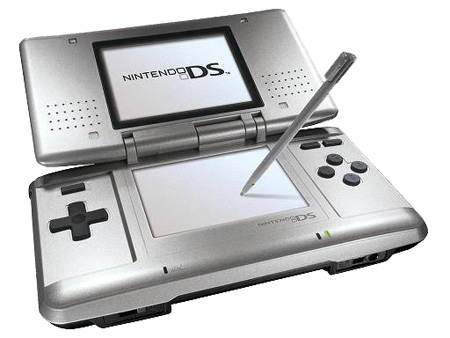'Magic' behind the touch screen
The screen of the iPhone, the DS game machine, the coffee table and the computer . help users to drag and drop icons and enter characters right on it without the keyboard developed according to different technologies with features private.
In terms of function, they all aim to feel the force of the finger or the pen click on it, considering what function the impacted position has, corresponding to which software. The difference lies in how the screen detects that impact.
There are 3 common types:

Nintendo DS uses resistive touch screen technology. Photo: Techfresh .
Resistive touchscreen is the most used device because it has the longest and cheapest price. It appears in touch-screen mobile phones (including some cheap Chinese phones), many tablet computers, Nintendo DS game consoles .
At the bottom of this screen is a layer of glass, on which there is a conductive layer and a resistor layer located a very thin distance apart. Above that is the class for users to touch.
So when you press down on the screen, the resistor will touch the conductive layer, changing the current flowing through them and the device can recognize the finger or pen touching it.
This is the cheapest method, but this way cannot support multi-touch (multiple fingers pressing at the same time) because of the limitations of the force-sensing mechanism. In addition, due to the use of multiple layers of materials, this screen is thick, consumes a lot of electricity for lighting and slow reactions.

Capacitive touch technology is applied to iPhone. Photo: Gadget-reviews .
Capacitive touchscreen (capacitive touchscreen) proved more attractive. Previously they were quite expensive but now prices have dropped and appeared in iPhone phones, Dell Latitude XT tablet screens .
Basically, the device has a layer of material on top of the screen surface with electricity flowing through it. Because humans also have magnetism, when touching this screen (assuming finger), it will create electrical variation. By identifying the most noise level on this surface, the device knows where the user is touching.
One can apply multitouch with this technology and due to less physical layer, the screen surface will be brighter. However, based on the interaction between electromagnetic fields, electrical conductivity . so if the user wears gloves, the operation will be difficult. In addition, if you want to use a pen instead of a finger, you must use a dedicated pen.

Surface computer of Microsoft coffee table uses technology
Infrared touch. Photo: Kuanhoong .
Infrared touchscreen (infrared touchscreen) is a loud technology on Microsoft coffee table computers. In theory, the image on its surface is projected from the bottom with infrared light. Below this surface are infrared cameras that can "see" the movement above so that when the light is reflected by the object (such as fingers, pens .), those images are processed and translated into move.
The outstanding advantage of this technique is that it supports very good multi-touch and low cost. However, the system is quite cumbersome and suitable for large devices in large spaces.
In addition, there are many other advanced touch screen technology in the world but not yet widely used. For example, a sound wave system that uses an energy converter and a reflector can detect that the ultrasound being transmitted between them is disconnected (meaning that an object is touching it). This surface without many layers should be 100% bright but dirt flying in the air can affect it.
Sharp (Japan) has also launched a touch-sensitive device using light-sensing technology integrated into the screen. They are sensitive enough to feel the finger to every pixel, increasing the multi-touch capability but, like infrared technology, this technique can be affected because of unwanted light.
Mary Lou Jepsen, an engineer in OLPC's low-cost laptop project, said they are developing a touchscreen based matrix of LCD screens. However, the product does not have the usual plug-and-play form but requires a specially encoded device for compatibility.
You should read it
- The best touchscreen phones 2011
- Useful shortcuts on iPhone with 3D Touch without your knowledge
- Did you know the tricks to use 3D Touch on iPhone?
- How to customize Touch Bar on Macbook Pro
- Apple will death 3D Touch on iPhone?
- Should you buy a touchscreen PC?
- iOS 11.3 disables iPhone touch screen being replaced by 3rd party
- Touch Eee PC Touch Netbook
May be interested
- How to fix iPhone touch screen not working
 broken iphone screen is a disaster. after all, we now use our phones for almost everything. if the touch screen does not work, using the phone may be difficult or even completely unusable.
broken iphone screen is a disaster. after all, we now use our phones for almost everything. if the touch screen does not work, using the phone may be difficult or even completely unusable. - How to set up Raspberry Pi touch screen
 raspberry pi comes with a variety of useful and handy gadgets. but one of the most popular utilities is the 7-inch touch screen for raspberry pi.
raspberry pi comes with a variety of useful and handy gadgets. but one of the most popular utilities is the 7-inch touch screen for raspberry pi. - The best touchscreen phones 2011
 many touch phones have been launched since the first iphone. however, not every product has a touch screen worth choosing.
many touch phones have been launched since the first iphone. however, not every product has a touch screen worth choosing. - How to disable touch screen input on phone
 with the touch lock application, you can temporarily lock the touch screen on your android phone and feel completely secure about children pressing the wrong key or important feature. here's how to use touch lock to turn off the touch screen on android.
with the touch lock application, you can temporarily lock the touch screen on your android phone and feel completely secure about children pressing the wrong key or important feature. here's how to use touch lock to turn off the touch screen on android. - How to customize Touch Bar on Macbook Pro
 basically the touch bar will provide users with a variety of shortcuts depending on the application being used and open on the main screen. however, if you don't like the default options, you can add or remove shortcuts to customize your touch bar in your own style.
basically the touch bar will provide users with a variety of shortcuts depending on the application being used and open on the main screen. however, if you don't like the default options, you can add or remove shortcuts to customize your touch bar in your own style. - Instructions for cleaning touch screens for phones and tablets
 touch screen phones or tablets after only a few times of use will often clog dirt, fingerprints or other traces. this will make the user feel uncomfortable, the screen is blurry or dimmed.
touch screen phones or tablets after only a few times of use will often clog dirt, fingerprints or other traces. this will make the user feel uncomfortable, the screen is blurry or dimmed. - Apple will death 3D Touch on iPhone?
 according to analysts, 3d touch - a feature that uses force on the iphone touch screen to preview content or quickly open apple apps will no longer appear on the iphone next year.
according to analysts, 3d touch - a feature that uses force on the iphone touch screen to preview content or quickly open apple apps will no longer appear on the iphone next year. - Microsoft and Adobe started to build a touch-screen Photoshop version
 a combination of 2 big guys will make using photoshop easier on the touch screen.
a combination of 2 big guys will make using photoshop easier on the touch screen. - Instructions to fix touch screen error on Windows 10
 here are some ways to fix errors on touch screens on windows 10 on laptop computers or large touch screens
here are some ways to fix errors on touch screens on windows 10 on laptop computers or large touch screens - How to disable touch screen in Windows 11
 the touch screen is a great piece of equipment, but it doesn't seem to be an indispensable element on windows computers in general.
the touch screen is a great piece of equipment, but it doesn't seem to be an indispensable element on windows computers in general.










 5 details 'ungainly' in Windows 7
5 details 'ungainly' in Windows 7 Web 2.0 applications will be twice as fast on Firefox 3.1
Web 2.0 applications will be twice as fast on Firefox 3.1 The first logo of famous technology firms
The first logo of famous technology firms The search engine and the race
The search engine and the race Consider about VMware Server 2.0 RC1
Consider about VMware Server 2.0 RC1 Fret select LCD screen - CRT
Fret select LCD screen - CRT